

 |
 |

|
Промышленный лизинг
Методички
Ц±кШ=1 иллл1М1Ы1[ Issue Management Process An issue is something that has happened that can threaten the success of your project. With issue management, you encounter typically four different scenarios: Unconscious issues (there, but unknown). Conscious issues (not publicly known, although discussed with the right people). Shared issues (shared but remain unresolved). Shared and resolved issues (the ideal scenario). (See Figure 8.4.)  Figure 8.4: Issue management process. The issue process is key to the successful delivery of any project. It ensures that each issue identified in the project environment is documented, prioritized, and resolved in an appropriate length of time. Issues cannot remain unresolved for an indefinite time. For the purpose of your project, you need to follow an issue management process. Start by tackling issues first. Concentrate on: Identifying current issues. Identifying themes among the issues (e.g., vendor issues, financial issues). Clarifying the issues. Prioritizing the issues (e.g., priority 1, or color code red, yellow, green). Selecting the issue you want to work on. Understanding why the issue exists. Selecting a solution with an action item(s). Issue management is introduced to this project through the implementation of five key processes. A formal process for the: Identification of project issues. Logging and prioritization of project issues. Determination of issue resolution actions. Monitoring and control of assigned issue resolution actions. Closure of project issues. Raise Issue This process provides the ability for any member of the project team to raise a project-related issue. The following procedures are undertaken: Issue originator identifies an issue applicable to a particular aspect of the project (e.g., scope, deliverables, time scales, organization). Issue originator completes an issue form and distributes the form to the project manager. Register Issue This process allows the project manager to review all issues raised and determine whether each issue is applicable to the project. This decision is based primarily on whether the issue impacts: A project deliverable specified in the project deliverables register. A quality deliverable specified in the quality plan. The time scale specified in the project plan. If the project manager considers the issue appropriate to the project, a formal issue is raised in the project issue register and an issue number is assigned. The project manager assigns an issue priority based on the level of impact of the issue to the project. Assign Issue Actions This process involves the formal review of the issue register by the project review group. The project review group reviews each issue in turn (based on issue priority) and may decide to: Close the issue in the issue register if there are no outstanding issue actions and the issue is no longer impacting the project. Raise a change request if the issue has resulted in the need for a change to the project. 1 2 3 4 5 6 7 8 9 10 11 12 13 14 15 16 17 18 19 20 21 22 23 24 25 26 27 28 29 30 31 32 33 34 35 36 37 38 39 40 41 42 43 44 45 46 47 48 49 50 51 52 53 54 55 56 57 58 59 60 61 62 63 64 65 66 67 68 69 70 71 72 73 74 75 [ 76 ] 77 78 79 80 81 82 83 84 85 86 87 88 89 90 91 92 93 94 95 96 97 98 99 100 101 |